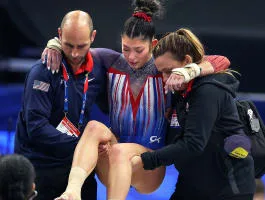
Achilles injuries, devastating in their impact, have recently derailed the Olympic aspirations of promising U.S. gymnastics contenders. These injuries are not only physically debilitating but also emotionally and psychologically taxing, particularly for athletes who have dedicated their lives to reaching the pinnacle of their sport. As the debate over injury prevention intensifies, it’s crucial to explore the underlying causes of Achilles injuries in gymnastics and examine strategies to mitigate their risk.
**Understanding Achilles Injuries in Gymnastics**
The Achilles tendon, a robust yet vulnerable band of tissue connecting the calf muscles to the heel bone, is essential for many of the dynamic movements in gymnastics, including jumps, landings, and explosive takeoffs. In gymnastics, the repetitive stress and high-impact activities put immense strain on this tendon. Overuse, combined with the intense physical demands of the sport, can lead to partial tears or ruptures, often precipitated by sudden increases in training intensity or volume.
**Factors Contributing to Achilles Injuries**
Several factors contribute to the risk of Achilles injuries in gymnastics:
1. **Repetitive Strain**: Gymnasts frequently perform high-impact routines involving multiple landings and jumps. The repetitive strain on the Achilles tendon can lead to overuse injuries if not properly managed.
2. **Biomechanics**: The biomechanics of gymnastics, including the forces generated during landings and the precision required in movements, place additional stress on the Achilles tendon. Poor technique or misalignment can exacerbate this stress.
3. **Training Loads**: Rapid increases in training intensity or volume can overwhelm the tendon’s capacity to recover and adapt, increasing the risk of injury.
4. **Footwear and Surfaces**: Training surfaces and footwear play a role in impact absorption and overall biomechanical alignment. Inadequate footwear or hard surfaces can heighten the risk of tendon strain.
5. **Pre-existing Conditions**: Athletes with pre-existing conditions, such as tight calf muscles or poor flexibility, may be more susceptible to Achilles injuries.
**Preventive Measures**
To reduce the risk of Achilles injuries, a multi-faceted approach focusing on prevention, early intervention, and appropriate management is essential:
1. **Proper Training Techniques**: Ensuring that gymnasts use correct technique during training and competition can help minimize excessive stress on the Achilles tendon. Coaches and trainers should emphasize proper landing mechanics and technique adjustments.
2. **Gradual Progression**: Training loads should increase gradually to allow the tendon time to adapt. Sudden changes in intensity or volume should be avoided, and athletes should follow well-structured conditioning programs.
3. **Strength and Flexibility Training**: Incorporating exercises to strengthen the calf muscles and improve the flexibility of the Achilles tendon can enhance resilience and reduce injury risk. Strength training and stretching routines should be tailored to the individual athlete’s needs.
4. **Recovery and Rest**: Adequate recovery time between intense training sessions is crucial for tendon repair and adaptation. Overtraining can lead to fatigue and increased injury risk, so incorporating rest and recovery periods is vital.
5. **Injury Monitoring and Early Intervention**: Monitoring for early signs of Achilles strain or discomfort is essential. Early intervention by medical professionals can prevent minor issues from escalating into severe injuries. Regular assessments and prompt treatment for any signs of discomfort can be beneficial.
6. **Equipment and Environment**: Ensuring that gymnasts train on appropriate surfaces and wear supportive footwear can help absorb impact and reduce strain on the Achilles tendon.
**Conclusion**
Achilles injuries have undeniably impacted the Olympic dreams of U.S. gymnastics contenders, underscoring the need for effective prevention strategies. By addressing training practices, biomechanics, and recovery protocols, and by promoting early intervention, the gymnastics community can work towards reducing the incidence of these debilitating injuries. While it may not be possible to eliminate all risks, a proactive and comprehensive approach can help safeguard athletes’ health and longevity in the sport.








